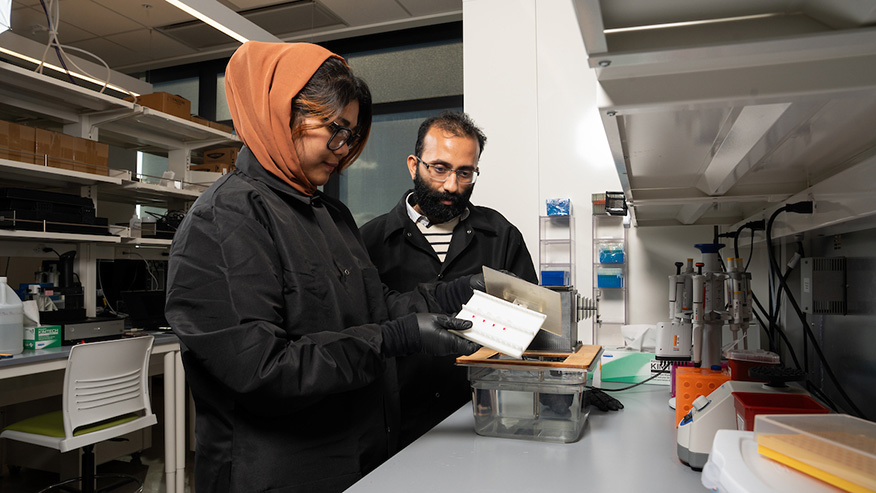Purdue and leading companies chart a taxonomy of 6G technologies
Research teams at companies including Cisco, Dell, Ericsson, Intel, Nokia and Qualcomm, along with Purdue University, issue “dictionary” of 12 technologies in 6G Global Roadmap taxonomy report

WEST LAFAYETTE, Ind. —
Today in Washington, D.C., 6G Global Roadmap: A Taxonomy is released to offer a taxonomy of technologies in the evolution from 5G — the fifth generation of cellular technology — to 6G. The document is the product of leading companies in the wireless industry, together with Purdue University, including:
- Cisco Systems
- Dell Technologies
- Ericsson
- Intel
- Nokia
- Qualcomm Technologies Inc.
“This technology report is meant to be a foundation of policies, not a policy itself. It is a taxonomy over the modularized layers and over time horizon this decade,” said Purdue University President Mung Chiang. “In the meantime, we strongly recommend the speeding up and scaling up of 5G deployments in the U.S. right now. More 5G infrastructure and resulting applications are essential to any road map to 6G.”
6G wireless networks promise not only faster speed, lower latency and better coverage, but also the connection of more devices than people and the offer of a foundational service to all sectors and across different types of networks and scenarios.
Purdue’s industry partners hold high opinions of what 6G can offer:
Michael Beesley, vice president and chief technology officer, Cisco Networking:
“Cisco has been honored to collaborate with Purdue University and our industry peers in putting together the 6G Roadmap taxonomy report. We feel that this report will serve as a powerful foundation for ongoing conversations around innovation, research, standards and use cases to ensure that the next generation of mobile technology helps to ensuring an inclusive future for all.”
Erik Ekudden, chief technology officer, Ericsson:
“5G is the innovation platform for consumer and business digitalization today. This report is an important step in forming the necessary partnerships that will be the foundation for the evolution of the mobile network toward 2030 with 5G Advanced and 6G.”
Nishant Batra, chief strategy and technology officer, Nokia:
“6G will expand and transform what a network can do, going beyond traditional performance metrics. Key dimensions, such as scalability, sustainability, trustworthiness and digital inclusion, will have significant impact on society in the coming 6G era. This detailed taxonomy report delves into the fundamental technical areas that will drive 6G development, which align with Nokia’s pioneering research on 6G over the last several years. In addition to promoting technical research and industry collaboration for the development of 6G, we must also address policy-related issues, such as the availability of new-spectrum, global standardization and an equitable, nondiscriminatory patent system.”
John Smee, senior vice president, engineering, Qualcomm Technologies Inc.:
“Robust connectivity is essential to many enterprises and consumers — that’s why it’s critical to continue scaling up 5G in the U.S. and globally and to research its next phase, 6G, which will take these technologies forward into the next decade, bringing benefits to industry and society when it launches.”
The report surveys the technical areas that are expected to drive 6G development and the important problems faced in these focus areas. These technical innovations describe a dozen enabling network architectures, protocols and tools in this decade’s evolution from 5G to 6G.
- Enabling ultra-low-latency applications
- Supporting intermittent connectivity
- Creating wireless service platforms
- Densifying cells
- Scaling up edge/fog computing
- Sharing spectrum
- Using sub-THz spectrum bands
- Sharing infrastructure
- Using open interfaces
- Utilizing artificial intelligence and machine learning
- Internetworking with Wi-Fi
- Internetworking with satellite networks
The task force of industry and academia will continue to collaborate toward its next report, which will address further recommendations for the 6G evolution.
About Purdue University
Purdue University is a public research institution with excellence at scale. Ranked among top 10 public universities and with two colleges in the top 4 in the United States, Purdue discovers and disseminates knowledge with a quality and at a scale second to none. More than 105,000 students study at Purdue across modalities and locations, with 50,000 in person on the West Lafayette campus. Committed to affordability and accessibility, Purdue’s main campus has frozen tuition 12 years in a row. See how Purdue never stops in the persistent pursuit of the next giant leap, including its first comprehensive urban campus in Indianapolis, the new Mitchell E. Daniels, Jr. School of Business, and Purdue Computes, at https://www.purdue.edu/president/strategic-initiatives.
Writer/Media contact: Brian Huchel, bhuchel@purdue.edu
Source: Mung Chiang



